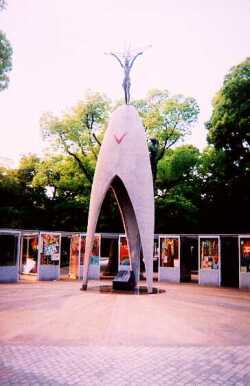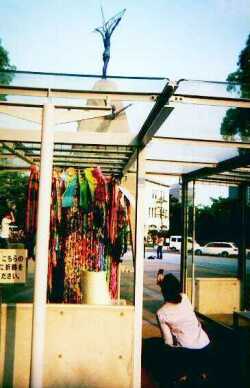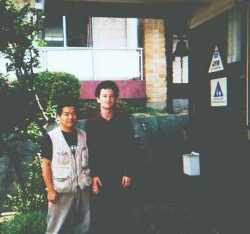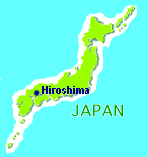The main attraction for me in Hiroshima
was, not surprisingly, the site
of the atomic bomb disaster and the Peace Park. It took a while to get
there, mostly because I was being stubborn about asking for directions.
Finally, I asked and found the site of the hypocenter and the Peace Park.
Isn't it a bit strange to see the site of such a terrible moment in history
transformed into a nice park? It is a great place for jogging and bicycling for
Hiroshima residents. I definitely did not want to have my picture taken next
to the evidence of this terrible act done by the United States. Needless to say,
my visit to Hiroshima drove home the point that nuclear bombs are never appropriate.
You are looking at the A-Bomb Dome which is across the river from the Peace Park.
In 1996, it was declared a UNESCO
World Heritage site. The atomic bomb exploded almost directly above it. Prior to that, it
had been the Industrial Promotion Hall. They left it standing as a constant
reminder to the tragedy at destroyed much of Hiroshima in 1945. |


|
|
Across the river from the A-Bomb Dome is the Peace Memorial Park. It is a large park,
relative to other parks I visited in Japan. There is a lot of open space dotted with
various memorials to the victims of the atomic blast.
At right, you see the Children's Peace Memorial, which was inspired by Sadako, a leukaemia
victim. When she got leukemia as a 10-year-old, she decided to fold 1000 cranes. She died
having folded 644 cranes. Her classmates folded the other 356. This inspired a nationwide
tradition of crane-folding. There are literally millions of paper cranes around the Peace
Memorial Park. It is definitely one of the highlights of the park.
|

|
|
Here you see a foreign woman taking some pictures of another crane-related monument. It
really is astounding to see all the cranes around the park, and to think about the devotion that
motivated people to make them.
|

|
|
At the youth hostel in Hiroshima, I met several fine Japanese people. Pictured at right is Masashi
Yana, who I ran into in the dining room of the hostel. He gave me shochu and we sat and conversed
for much of the night, along with a woman who works there and my roommate, Akio Hamada. Among other
things, we talked about World War II. I found my Japanese completely inadequate for talking about
war and politics. Fortunately, his English was better than my Japanese, so we spoke a mixture of the
two.
|

|
|
This is Akio Hamada. He was my only roommate at the youth hostel. He was a pleasure to chat with. Here, we are standing in the lobby of the Hiroshima Youth Hostel. The hostel was great. It wasn't too crowded. Oh yeah, it was really cheap! Only ¥1770 per night (US ≈$15).
|

|
| On my second day in Hiroshima, I started with some errands (phone calls, post office, etc.) and then headed
for Hiroshima-jo, a castle. On the way, I ran into some middle school students who came and practiced their
English (very little) with me. You see them here.
|

|
|
The approach to the castle took me through Chuo Park, a beautiful area with a temple, big grassy areas,
and a little stream with coi (carp).
|

|
|
Here's my picture of Hiroshima-jo (castle). You can find a better one at this link.
Hiroshima-jo was built in 1589 by the feudal lord Terumoto Mori. In 1931, it was designated one of Japan's national treasures. It was destroyed
in the atomic blast, but has since been reconstructed, like many castles in Japan. Inside, there is a museum. I didn't stay inside very long. It was
too nice a day to be inside.
|

|
|
After seeing the castle, I returned to Chuo Park and studied Japanese
for a couple hours until the mosquitoes set in.
|

|
 Hiroshima
Hiroshima










